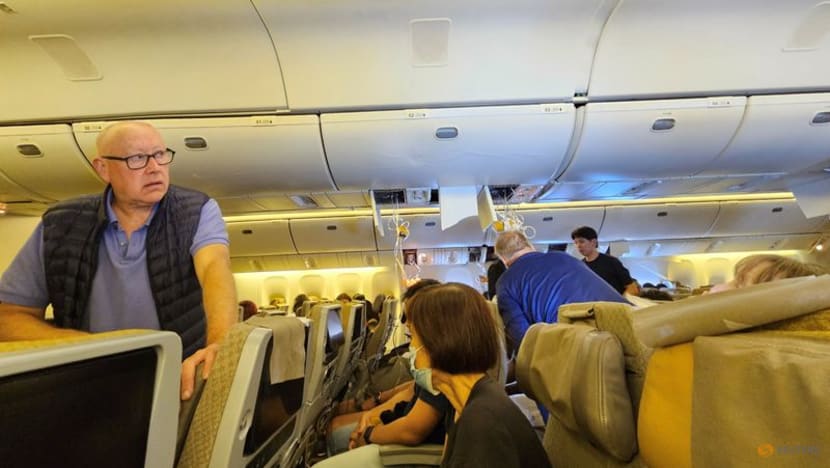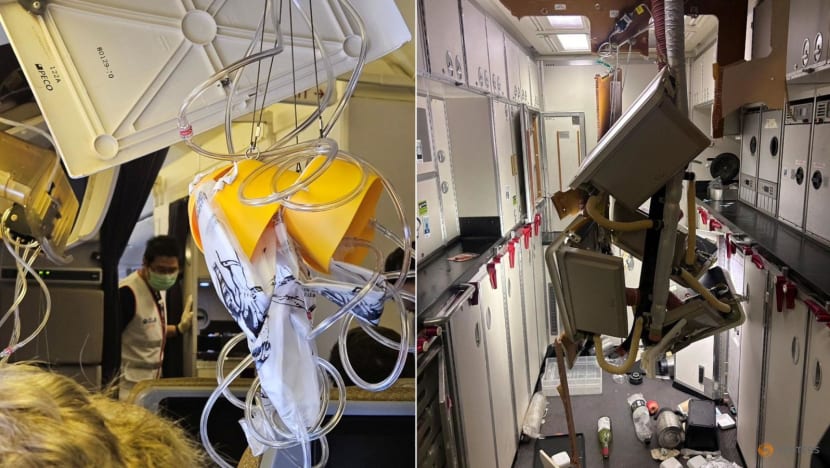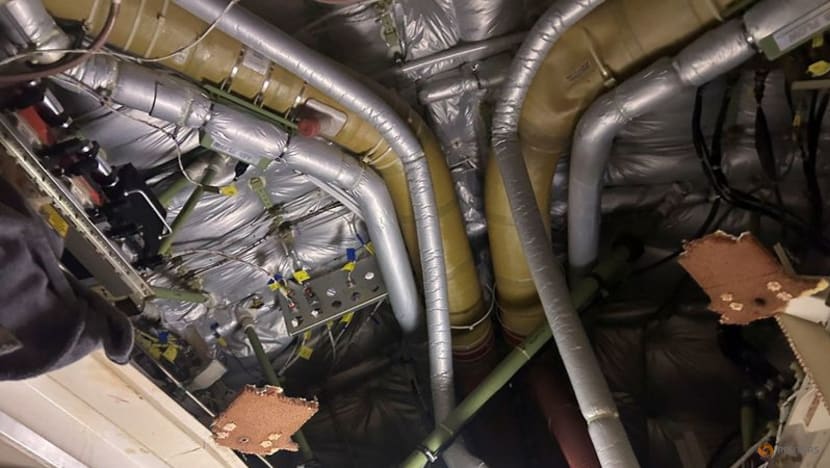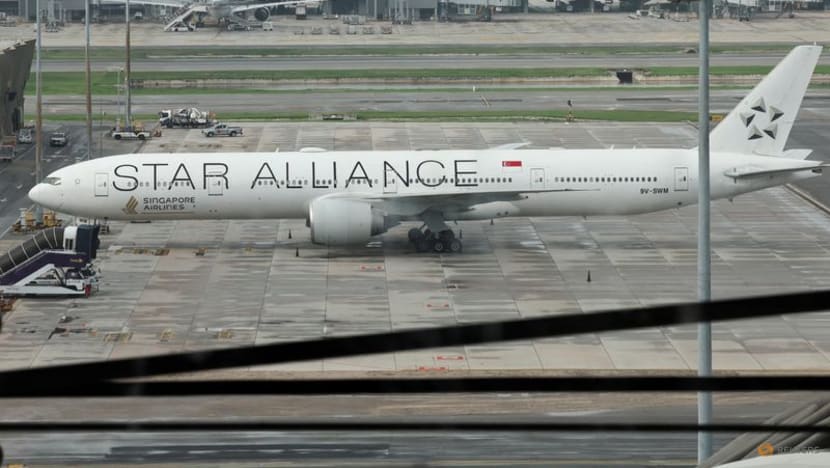CNA Explains: How often does turbulence occur, and how did it affect flight SQ321?
The SQ321 incident highlights the potential dangers of turbulence, especially as scientists warn its occurrence could worsen with climate change.






This audio is generated by an AI tool.
Extreme turbulence hit Singapore Airlines (SIA) flight SQ321 from London to Singapore on Tuesday (May 21), and forced the aircraft to make an emergency landing at Bangkok's Suvarnabhumi Airport.
A 73-year-old British man died of a suspected heart attack and at least 30 people were injured, some critically.
The incident highlighted the potential dangers of turbulence, especially as scientists warn its occurrence could worsen with climate change.
But what causes turbulence, can it be avoided, and how can you keep yourself safe?
What causes turbulence?
Turbulence occurs when an aircraft is caught up in a sudden shift in airflow caused by changes in wind speed and direction.
They can be created by atmospheric pressure, thunderstorms, mountain ranges, or strong air currents called jet streams.
Planes can shake or jolt when encountering turbulence, much like boats in choppy waters.
Does it cause planes to plunge?
Flight tracking data showed SQ321 experienced a 6,000-foot (1.8km) drop within four minutes.
While turbulence can cause planes to lose altitude quickly, experts said the sudden dive for an aircraft the size of the Boeing 777-300ER was highly abnormal. Instead, it would more likely have been the pilots’ reaction, said analysts.
“That amount of descent (relative to) time may not be subjected to a downdraft, it could be more indicative of the pilots reacting to the situation,” Mr Michael Daniel, managing director of consultancy firm Aviation Insight, told CNA's Singapore Tonight.
Can turbulence be avoided?
Turbulence can be detected on a plane’s weather radar if they contain water particles.
“Normally, for turbulence caused by movement of clouds, pilots will be alerted so they can avoid it or notify the crew and passengers to wear their seatbelts,” Mr Shantanu Gangakhedkar, senior aviation consultant at market research firm Frost and Sullivan, told CNA938.
Pilots also receive pre-flight weather briefing that includes information about potential turbulence, allowing them to make adjustments to the route, altitude or speed to minimise the impact.
However, the least predictable type of disturbance is clear-air turbulence, which can appear without any visible signs.
What is clear-air turbulence?
These invisible pockets of air can occur at high altitudes above 30,000 ft in clear skies.
Clear-air turbulence is often behind injuries as it can happen without warning, and flight crew may not have time to instruct passengers to fasten their seatbelts.
Currently, there is no technology to detect the phenomenon.
NASA says it is developing an early-warning system, but experts caution it could take years.
Multiple analysts CNA spoke to believe SQ321 was hit by clear-air turbulence due to the sudden nature of the incident.
“Looking at the number of injuries, SQ321 (likely) encountered extreme clear-air turbulence, where a plane can be tossed about violently (and without notice),” said independent aviation analyst Alvin Lie.
“Clear-air turbulence can hit anytime, anywhere, without prior knowledge. I believe there were many other planes flying in that area at the same time (but they were not affected). It was just hard luck (for SQ321).”
How often does extreme turbulence occur?
The SIA plane was hit by “sudden extreme turbulence”, an intensity experts say planes rarely encounter.
Turbulence intensity is classified by light, moderate, severe and extreme, according to the United States National Oceanic and Atmospheric Administration’s (NOAA) National Weather Service.
During light turbulence – which happens fairly frequently – passengers may experience slight bumpiness.
During extreme turbulence – which very rarely occurs – an aircraft may be tossed about violently and be momentarily impossible to control. It may also cause structural damage.
Experts say commercial aircraft are designed to fly through difficult weather conditions.
Turbulence-related fatalities or serious injuries also remain extremely rare.
Are some routes more bumpy than others?
Some regions are more prone to turbulence, particularly areas with more weather activities.
“Southeast Asia is a region known to have more storm activities, and hence likely to experience more turbulence,” said Mr Leithen Francis, managing director of Francis & Low, a marketing agency that specialises in aviation.
The SIA flight was over the Irrawaddy Basin in Myanmar when it encountered the sudden and extreme turbulence.
Scientists have warned that severe turbulence has jumped by 55 per cent in the past 40 years, and is expected to increase further due to the impact of climate change.
How do people get hurt during turbulence?
Most turbulence-related injuries happen because passengers and crew members are not buckled down.
Sudden and severe movements of a plane during turbulence may cause people to be thrown around the cabin.
In the case of SQ321, witnesses said those not wearing a seatbelt were launched into the ceiling, hitting baggage cabins overhead.
Even when buckled in, passengers may be hit by flying items or falling luggage if overhead compartments are flung open.
Experts highlight crew members are most exposed to injury, as they are not strapped in most of the time, including having to check passengers’ seatbelts when the signs light up.
What can passengers do to stay safe?
Be diligent, say experts.
Buckle up when seated, even at cruising altitude when the “fasten seatbelt” sign is not on.
Attendants also advise passengers to pay attention to the safety briefing before take-off, and listen to crew and pilot announcements during a flight.
“We can’t anticipate sudden turbulence, which might cause severe injuries when people are not buckled in. So, when you are in the seat, be diligent and buckle up, whether the fasten seatbelt sign is on or not,” said Mr Daniel.

















